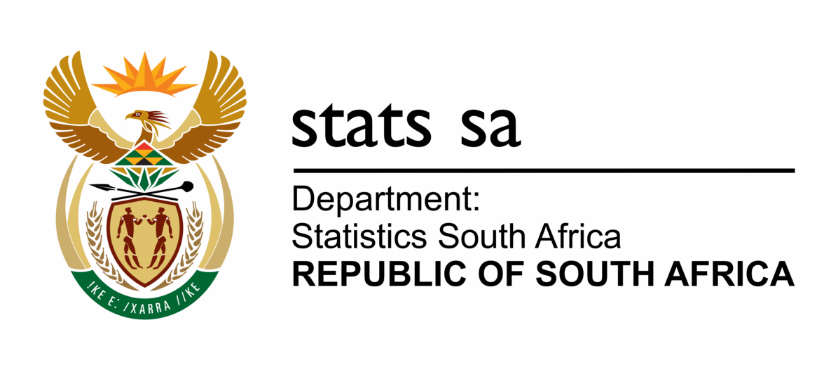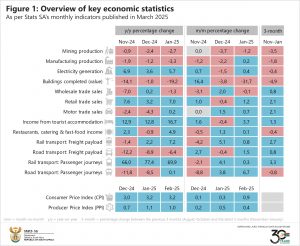Economic wrap-up for March 2025
Stats SA had a bumper schedule in March, with 35 releases published on a wide range of topics. Key economic outputs included the latest gross domestic product (GDP) estimates, formal-sector employment, data on electricity generation and a comprehensive set of energy flow accounts.
Agriculture, trade and finance push the economy forward
After a bumpy third quarter in 2024, South Africa’s GDP expanded by 0,6% in the fourth quarter, its strongest rise since the second quarter of 2023. The agriculture industry was the main driver of this upward growth on the supply (production) side of the economy, with trade and finance providing additional support. Other industries performed poorly with manufacturing and transport, storage & communication the most significant negative contributors. Mining was also weaker.
Household expenditure drove much of the upward momentum on the demand (expenditure) side of the economy. If we look at data from the previous year, the fourth quarter of 2024 was stronger than the fourth quarter of 2023. Household expenditure was up by 2,3% in volume terms, indicating that consumers are facing less strain.
Although December accounted for the biggest slice of consumer spending in the fourth quarter, there was a sharp year-on-year increase in retail trade sales in November 2024.1 This may suggest a re-emergence of Black Friday.
Formal-sector employment expands
Positive festive cheer and stronger retail sales were mirrored by employment numbers in the formal non-agricultural sector. The trade industry created 42 000 jobs in the fourth quarter of 2024, making it the largest positive contributor to overall employment growth. Business services, transport and electricity also contributed positively. Other industries recorded declines with community services shedding the most jobs. Construction, manufacturing and mining also recorded declines. The formal non-agricultural sector created an estimated 12 000 jobs overall. Despite this increase, employment in the sector remains below the peak reached in the third quarter of 2023.
The latest indicators for January
Mining’s economic wobble in the fourth quarter carried through into January, with production decreasing by 2,7% year-on-year and by 1,2% month-on-month (Figure 1). Iron ore was the largest negative contributor to the year-on-year decline. Coal, platinum group metals and chromium ore also performed poorly.
Manufacturing weakened by 3,3% year-on-year, dragged lower mainly by petroleum, chemical, rubber & plastics. The automotive division continued a downward trend, recording its ninth consecutive month of year-on-year decline. This was mainly due to a slowdown in the production of parts and accessories for motor vehicles.
Other sectors that recorded slower economic activity in January include construction (buildings completed as recorded by large municipalities), wholesale trade and road freight transport.
On the upside, passenger transport (both road and rail); rail freight transport; restaurants, catering & fast-food; tourist accommodation; motor trade; retail trade; and electricity generation registered positive year-on-year growth rates.
Electricity generation in positive territory, but still below all-time high
The rise in electricity generation in January continues a positive trend. On a year-on-year basis, growth has been consistently positive for just over a year. The country produced more electricity in 2024 than it did in 2023 or 2022.
Despite this improvement, national electricity generation in 2024 was still 10% lower than the all-time annual peak reached in 2007.
Coal accounts for almost two-thirds of energy supply
Electricity generation depends mainly on locally produced coal, according to a recent report on the flow of energy products in the economy. Coal provided the bulk of overall energy supply in 2021, with much of it used in the production of electricity.
Electricity was the third largest source of energy for households. Biofuels (e.g. wood used for heating and cooking) accounted for almost half of household energy use in 2021, followed by oil & oil products (e.g. paraffin) and electricity.
Other notable releases in March
Local government plays an important role in the provision of electricity and other services to households. The latest Non-financial census of municipalities report provides data received from municipalities on service provision, free basic services, indigent households, municipal employment, and the provision of municipal bucket toilets.
Stats SA also published detailed reports on the forestry & logging and ocean (marine) fishery industries. Both reports provide industry-specific data on income; expenditure; sales; concentration ratios; small, medium and large enterprises; and employment.
Interested to know more?
Keep up to date with our publication schedule here. For a comprehensive list of products and releases, download our catalogue here. For a regular update of indicators and infographics, visit our data story feed and download the latest edition of the Stats Biz newsletter.


